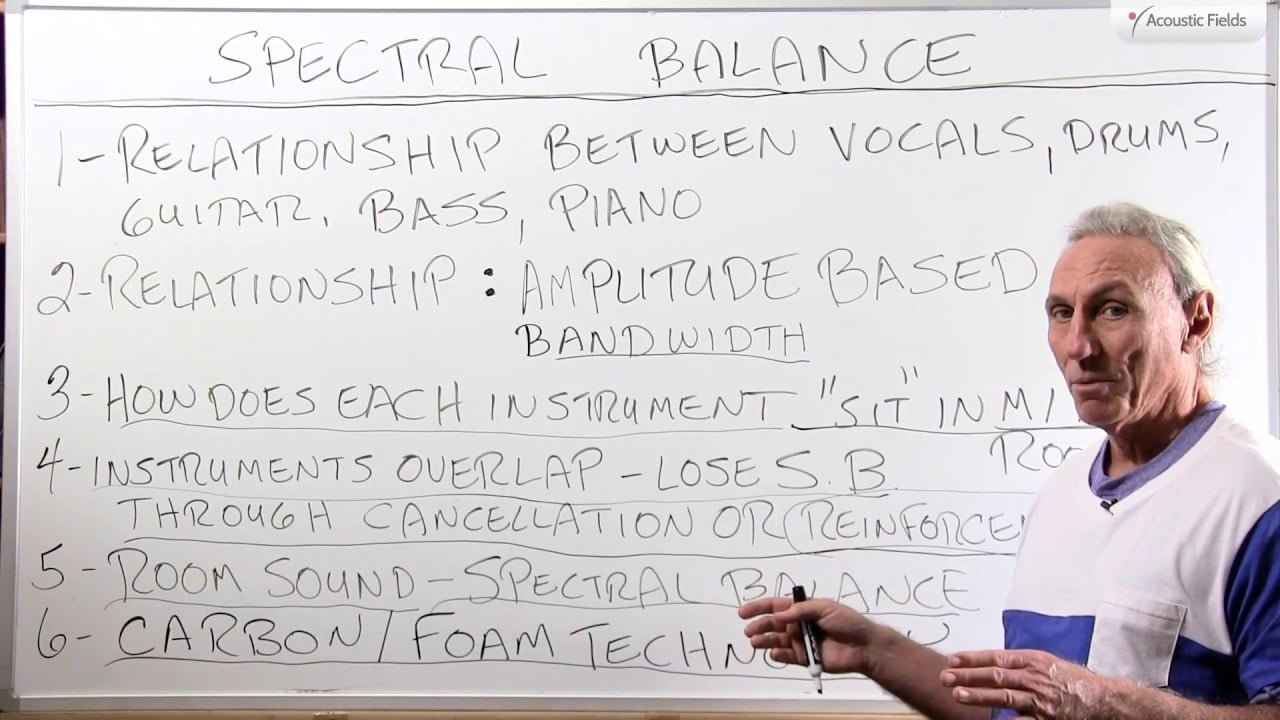Today we’re going to talk about Spectral Balance. Spectral Balance is a term that Mastering Engineers use constantly and let’s just break it apart. Balance of Spectrum, so balancing all the sounds that are in your mix so that’s really a big important function of a mastering engineer and the goal of mixing engineer is to give the mastering engineer a balanced spectral analysis so to speak. So what is Spectral Balance? it’s the relationship between everything, vocals, drums, guitar, bass, piano, anything that you’re recording.
It’s the relationship to that energy with the other energies in the spectrum so in the frequency response. So it’s a relationship based on strength, amplitude, bandwidth, how much energy the instrument produces, at what frequency versus other frequencies and other instruments, how each instrument sits in the mix and you’ve heard this term many times. It’s a way that engineers bring up something or decrease something in the mix and how they position it in the mix and vocals are really critical with this because vocals are a big component of how we connect to music emotionally so how the engineer positions the vocal in the mix will have a lot to do with whether the vocals are more involved or less involved. Harmonies, background vocals, a lot of this are important in Spectral Balance.
This is the overlapping of instruments because all instruments share common frequencies, even drums. Drums go a little bit lower than most instruments but symbols and high hats and things like that can get in the same frequency response range as guitars and other higher frequency producing instruments. So when they overlap we have cancellation or reinforcement occurring so if you get too much energy at certain frequencies… and we struggled with this back in the analog days with tape, when we had too much energy at a certain frequency it saturated the tape and you couldn’t hear anything or the other end of the spectrum is you hear too much, a big strong kick drum, overwhelms all the other instruments in the mix. So Spectral Balance is very important in our mixes, very important to the mastering engineer but equally important in room sound so when we design rooms we have to keep this Spectral Balance term in place because it’s important to make sure that the room can handle all the frequencies so that the mix engineer can get all the frequencies through the microphone into the recording process and then at the other end the mastering engineer can balance everything out.
So this is why I paid special attention to our carbon and our foam technologies and our rooms are noted for very high resolution and very smooth response curves and the reason they’re known for that, especially in the low end is because I want to make sure you hear everything. I want to make sure that you can hear everything in the music and not everything in the room so that’s why I paid special attention to our carbon technology and our foam technology and the rates and levels of absorption that those two technologies exhibit. They complement Spectral Balance and they do a better job in the low end than anything currently in the market place and I’ll stand behind that with the money back guarantee. So I’m really passionate about balance and Spectral Balance because I want to hear everything the artist is doing when they’re singing, when they’re playing and mainly what the engineer is doing when he’s recording to that.
So good quality sound like we always say is a combination of doing a lot of little things correct but mainly in the correct sequence also. So this is why I’ve spent years and years with this technology and getting these foam curves, absorption curves and our carbon curves correct. So I hope that helps define Spectral Balance for us and the very important term in both our rooms and in our recording engineering process.
—
This is an unedited transcript from our video series from Acoustic Fields. There will be some errors in grammar and sentence structure that occur during this translation process.
For complete understanding and comprehension, please view the video which is included in this text. For any additional information regarding this topic or others relating to room acoustics, please contact us directly at:
P: 520 – 392 – 9486







